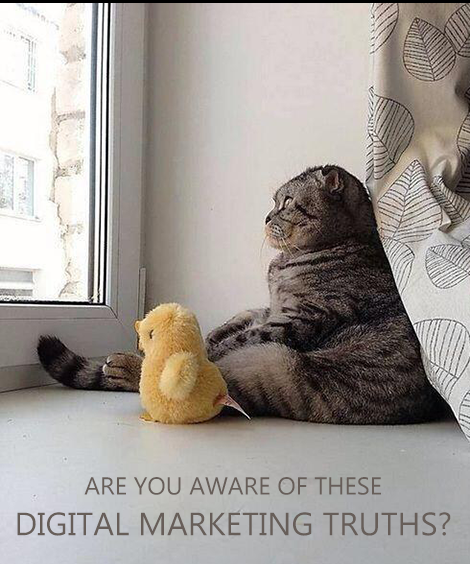
6 digital marketing truths you should be aware of, even if you ignore the rest.
If you feel like things in digital marketing move too fast, you’re right. Things change all the time. I might spend ages creating a video on how to shorten URLs for Twitter and then a better way might come along, meaning I have to do that video all over. But there are certain things – thought processes, concepts, and cold hard truths – that are just always true – when it comes to marketing yourself, your business or organisation online. Here are 6 of them.
It’s not about making a sale, it’s about making an impression
You may want to use digital marketing and social media to improve sales. And it can, for sure. That’s why millions of businesses all around the world spend so much time creating content, being active and keeping in touch with people on social media. It’s the impression you make that will mean people are more likely to choose you, when the time comes.
So, while it won’t get immediate results (or it might), by the time someone asks for you to help them, they will feel like they know, like and trust you – simply because you have been consistently there in their social media channels, you sometimes promoted others, you were clear in your message, and you shared good content (that you either created or credited). If this seems again like a whole lot of hard work – trust me – you can get used to it, quicker and easier than you think. And then it’s second nature, and you won’t look back.
Strike a balance – Combine variety with consistency
You will need to be consistent with how often you are there, and more or less the topics you talk about – the advice you give, and the stories you tell. These will show people what your niche is, so they know you’re the expert in your field.
However, you don’t want to be repeating yourself – if all you ever did was post 9 “tips of the day” Tweets, 9 days in a row- that would be boring to your audience. Mix things up – a variety of types of tweets, types of headlines, and types of images shared. That will mean people find your posts and sharing interesting and they know what they can expect, but you’re not too predictable.
Compare this to a friendship – a business friendship.
Nowadays, people don’t want to be sold to, hassled, or bombarded with promotions. And it’s true that “people buy people”. They want to make their own decisions of who to buy from. And they will choose the company that was there for them – was consistently around – like a good friend. A good friend is there for you, answering questions, being helpful and approachable, and getting in touch with something that they think would be useful to you, or something that made them think of you. A good friend gives you space when you need it. A good friend knows and understands you.
Having a plan will save you from wasting your time.
Here’s where it’s different from the friendship analogy. If you plan ahead for your marketing, you’re far more likely to win. This might be something simple like “I will check Twitter daily and chat to people who say interesting things – and I will make sure I share useful stuff”. Or it might be something more sophisticated, like a content calendar that gives you a guide on when to publish which blog posts, when you will be doing the “tip of the week” and how often you will create Instagram hashtags for user generated content. The plan is not there to stop you from being spontaneous. It’s there to get your thinking right and to ensure you don’t get too busy and disappear.
Think about your audience – not just you
While it’s great to share interesting “behind the scenes” things about your business, tell stories, and show personality, when considering what to post on social networks, what topics to include in your newsletter, or what to write about in your blog – you need to start with your audience. Ask yourself: what are they worried about? What would be useful for them? What questions do you get from them? And then that will be the basis for most of your content. Things like:
- Answering each frequently asked question in a separate blog post
- Creating a list of common sense tips you know well but your clients don’t know that well – and sharing these amongst your social network
- Taking one of those objections you hear so often from those who are NOT buying your services – and incorporating into your headline eg “How to look good in your corporate pictures – even if you’re not photogenic” or “Accountants only pretend to be boring to throw you off – here’s what we know that you don’t”
- Create a list of useful resources relating to your business that your audience might want to try, and write a blog post or a G+ post about them – and share this on Twitter, LinkedIn, G+
Set things up properly and pay attention to detail
Even though people are busy and they may miss the majority of your posts, it’s still important, when setting up your blog, your social media channels, or your newsletter – to start with proper setup. This means:
- Writing your bio out considering the word count and nature of each channel
- Using the right sized banners, profile pictures, and background images
- Using good spacing, image quality, and typography, in keeping with your branding
- Checking spelling grammar and punctuation
- Filling out all the different captions, headlines, and labels whenever you post
Sounds like a lot of work? It is initially, but then it’s done and once you get the habit right, this attention to detail will make each post you do effective, useful and interesting for your audience.
So there you go – 6.
You know I have a few more, can you believe it? But I will keep them for another time. Please comment below and if you would like a free half hour call with me, to talk about what all this means for you, email me with the hashtag #DigitalMarketingTruths – and we can set it up!
Photo credit: Instagram: @famousniki Facebook: FamousNiki


